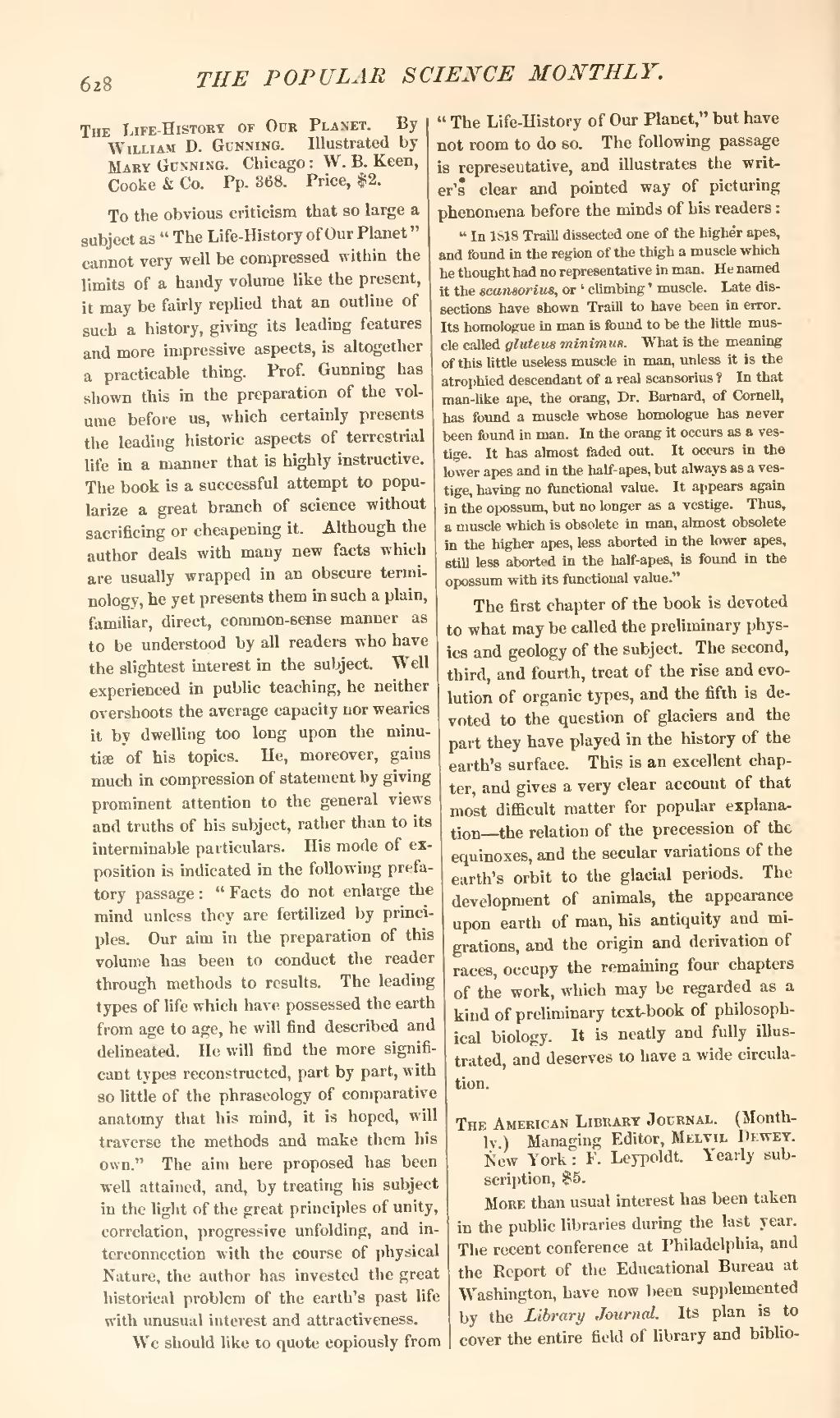The Life-History of Our Planet. By William D. Gunning. Illustrated by Mary Gunning. Chicago: W. B. Keen, Cooke & Co. Pp. 368. Price, $2.
To the obvious criticism that so large a subject as "The Life-History of Our Planet" cannot very well be compressed within the limits of a handy volume like the present, it may be fairly replied that an outline of such a history, giving its leading features and more impressive aspects, is altogether a practicable thing. Prof. Gunning has shown this in the preparation of the volume before us, which certainly presents the leading historic aspects of terrestrial life in a manner that is highly instructive. The book is a successful attempt to popularize a great branch of science without sacrificing or cheapening it. Although the author deals with many new facts which are usually wrapped in an obscure terminology, he yet presents them in such a plain, familiar, direct, common-sense manner as to be understood by all readers who have the slightest interest in the subject. Well experienced in public teaching, he neither overshoots the average capacity nor wearies it by dwelling too long upon the minutia? of his topics. He, moreover, gains much in compression of statement by giving prominent attention to the general views and truths of his subject, rather than to its interminable particulars. His mode of exposition is indicated in the following prefatory passage: "Facts do not enlarge the mind unless they are fertilized by principles. Our aim in the preparation of this volume has been to conduct the reader through methods to results. The leading types of life which have possessed the earth from age to age, he will find described and delineated. He will find the more significant types reconstructed, part by part, with so little of the phraseology of comparative anatomy that his mind, it is hoped, will traverse the methods and make them his own." The aim here proposed has been well attained, and, by treating his subject in the light of the great principles of unity, correlation, progressive unfolding, and interconnection with the course of physical Nature, the author has invested the great historical problem of the earth's past life with unusual interest and attractiveness. We should like to quote copiously from "The Life-History of Our Planet," but have not room to do so. The following passage is representative, and illustrates the writer's clear and pointed way of picturing phenomena before the minds of his readers:
"In 1818 Traill dissected one of the higher apes, and found in the region of the thigh a muscle which he thought had no representative in man. He named it the scansorius, or 'climbing' muscle. Late dissections have shown Traill to have been in error. Its homologue in man is found to be the little muscle called gluteus minimus. What is the meaning of this little useless muscle in man, unless it is the atrophied descendant of a real scansorius? In that man-like ape, the orang, Dr. Barnard, of Cornell, has found a muscle whose homologue has never been found in man. In the orang it occurs as a vestige. It has almost faded out. It occurs in the lower apes and in the half-apes, but always as a vestige, having no functional value. It appears again in the opossum, but no longer as a vestige. Thus, a muscle which is obsolete in man, almost obsolete in the higher apes, less aborted in the lower apes, still less aborted in the half-apes, is found in the opossum with its functional value."
The first chapter of the book is devoted to what may be called the preliminary physics and geology of the subject. The second, third, and fourth, treat of the rise and evolution of organic types, and the fifth is devoted to the question of glaciers and the part they have played in the history of the earth's surface. This is an excellent chapter and gives a very clear account of that most difficult matter for popular explanation—the relation of the precession of the equinoxes, and the secular variations of the earth's orbit to the glacial periods. The development of animals, the appearance upon earth of man, his antiquity and migrations, and the origin and derivation of races, occupy the remaining four chapters of the work, which may be regarded as a kind of preliminary text-book of philosophical biology. It is neatly and fully illustrated, and deserves to have a wide circulation.
The American Library Journal. (Monthly.) Managing Editor, Melvil Dewey. New York: F. Leypoldt. Yearly subscription, $5.
More than usual interest has been taken in the public libraries during the last year. The recent conference at Philadelphia, and the Report of the Educational Bureau at Washington, have now been supplemented by the Library Journal. Its plan is to cover the entire field of library and biblio-
